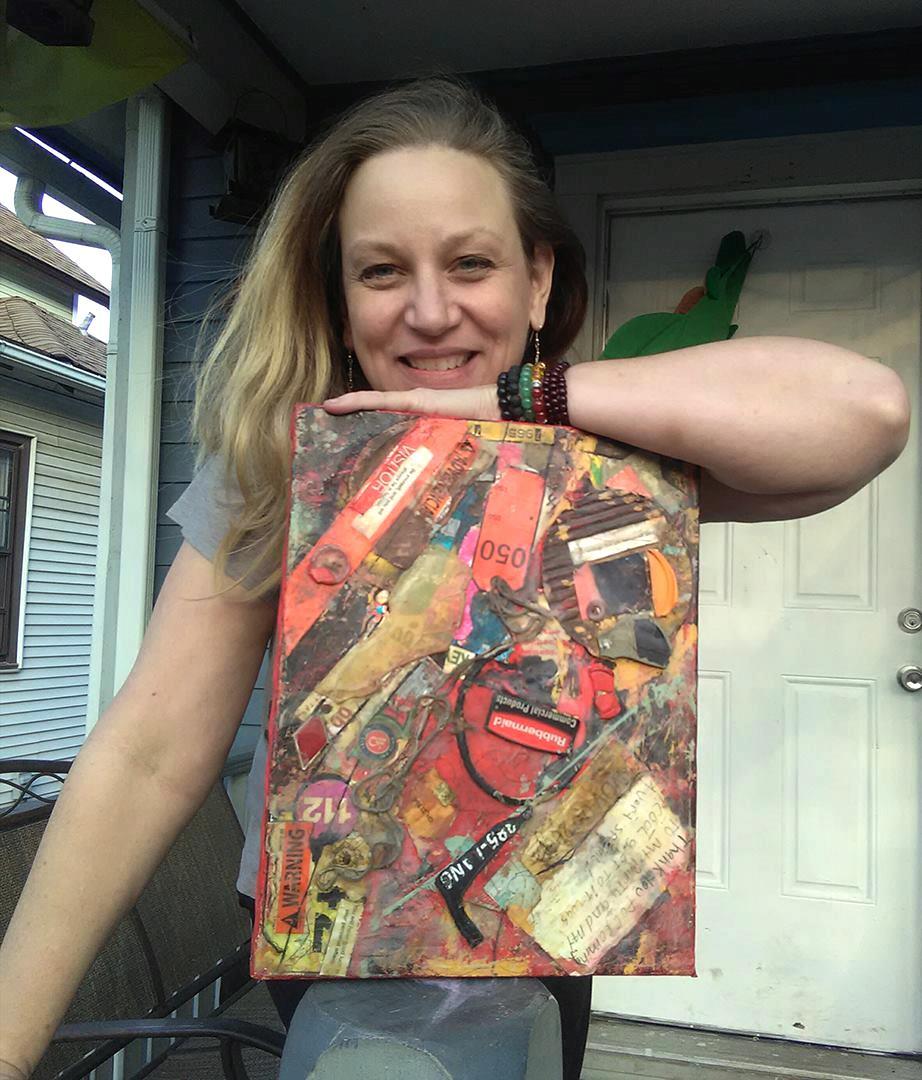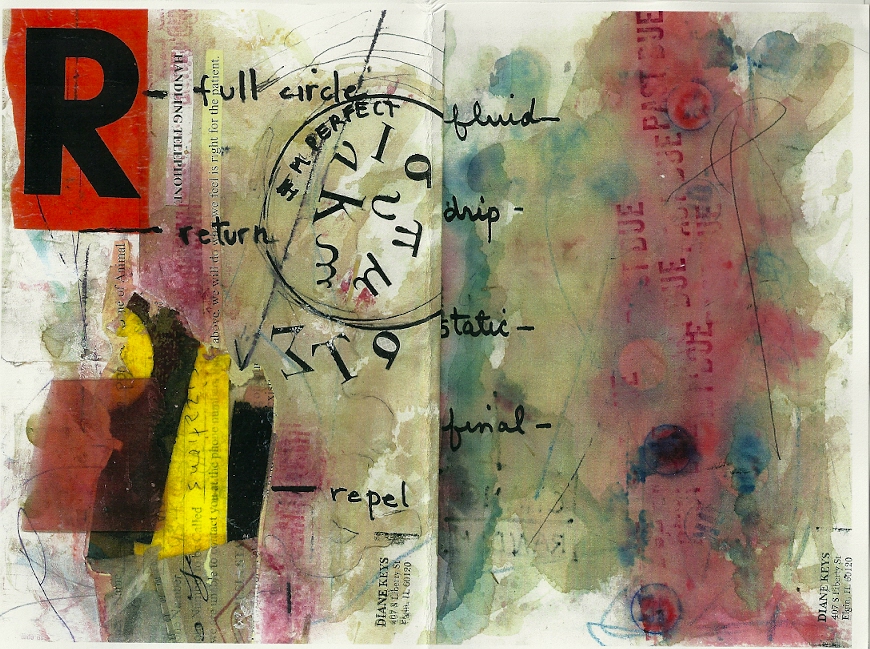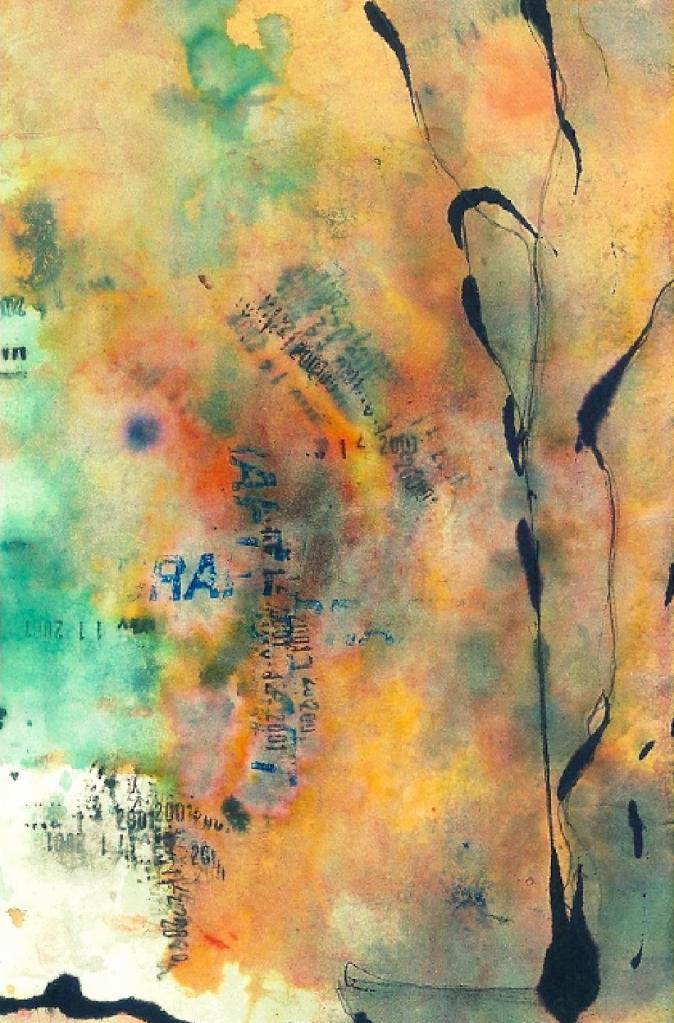Note: As part of the conclusion of the Karnival of Trash Mail Art Call, I conducted an interview with "Queen of Trashpo" Diane Keys. This appears on the M-L blog, but I will re-post the interview here for IUOMA members and especially those who have been so generous in participating in the KoT.
During the last five years, Diane Keys has emerged as an acclaimed artist, visual poet and performance artist through her involvement in the Eternal Network aka the International Mail Art Network. She has produced a significant body of collage, collaborations, artist books and videos, among other creations. She is probably most widely known for her involvement in Trashpo (trash poetry), a form of visual poetry first conceptualized by Jim Leftwich and circulated via the mail art network. Diane Keys’ fans and correspondents have established DKult in her honor, a group similar to the fan clubs Ray Johnson created through the New York Correspondance [sic] School. As the result of DKult’s propensity to invent narratives and mythologize, many misconceptions exist concerning the facts of Diane Keys’ life. Now, for the first time, M-L sets the record straight with this exclusive, three-part interview conducted in early 2017.
M-L: Can you give us an overview of your life narrative and your development as an artist?
DK: I was a child prodigy in ballet, mainly because I had a mother who tried to live her unfulfilled dreams vicariously through me. I was pushed, pressed and over-controlled with a rigid regimen of schools and classes. Starting at age 13, I was sent to boarding schools for the arts just like the Fame school, although I never saw any dancing on the tables. I attended high school at the North Carolina School of the Arts [NCSA] for ballet. This is located in Winston-Salem, the hometown of Sir Richard Canard. He lived right near the school, although I don’t think he was there when I attended. If I had met him, maybe I would have found mail art earlier and my destiny would have been different.
As it was, I was entranced by and jealous of the visual arts students. I hadn’t done more than just sketching, so I could never have been accepted into such a competitive program. I longed for the free, creative expression that was lacking in ballet. What I remember most is their environmental sculptures. Someone made a gorgeous woven hammock out of kudzu vines in the woods behind the school. High school at NCSA was life-changing for me, amazing and also extremely difficult. Aside from extreme pressure, the most painful part of it was that dance and ballet were never my true passion.
M-L: Many references are made in online materials to your studies at Northwestern University [Illinois, USA] and your training as an actress. Some claims, in fact, seem a bit outlandish. Can you separate fact from fiction for us?
DK: After graduation, like many NCSA students, I went to Manhattan [New York City]. I took an acting workshop taught by the dean of the theater department at Northwestern University. I’ll never forget walking with him one day, and we were caught in the rain. He said I looked like a wet cat. Then he told me, ‘You are too smart to just be dancing.’ He invited me to return to Chicago and to attend Northwestern University, which I did.
This was the first major life decision I was able to make for myself. I believe it is one of the best decisions I ever made. Oddly, it wasn’t even something my mother approved. I wanted to enter the College of Arts & Sciences at Northwestern; but while my test scores were high, I lacked the academic prep school background for a highly selective university. NCSA was very weak academically. Instead, I was admitted to the theater department because I had been performing my entire life, not theater but ballet.
Theater was also not my passion, but it afforded me the opportunity to study the things that interested me most such as philosophy, sociology, history, English and writing. I was one of nine people admitted into an intensive poetry program, and I was a research assistant for a medieval historian. I lived with an art major who was studying with Ed Paschke. Yes, I was jealous again as I heard about the performance art pieces her class was doing. I remember imagining what I would do.
Vispo by Diane Keys
M-L: What led you to settle in Elgin, Illinois?
DK: After graduation, I worked in several Tennessee cities doing musical theater, ballet and modeling for fine art photographers. I choreographed and taught as well. I was completely fascinated with the creative process of photography. I became more and more interested in photography. One photographer I worked with – Pete Ceren – proved to be an excellent teacher.
At the age of 25, I was completely burned out. My life actually began at 25 when I realized I could not go on living in a box decorated by the desires and constructs of others. I began honoring who I was, and that had nothing to do with dance, theater, fame, compromising or being a player on the main stage. Following my natural inclinations, I have always have been a backstage/behind-the-scenes person. I was just never allowed to be.
I came back to Chicago, started writing a novel, radio show, poetry, short stories and doing black and white photography. Ironically, my novel was about one third finished when I started using it as scratch paper and it ended up in the trash. Navigating my uncertain world through art, writing and collage was a life-saving journey.
I worked a ‘normal’ job in international business, which I hated. The only good thing that came out of it was that everyone intuitively gave me the international stamps they received. I kept this accidental collection in a shoe box, unsure what I would do with them. Long after the glorious day I quit, I collaged them all onto the box and started reading about design. I collected things that interested me and collaged on furniture. A lot of it was essentially trash. A friend had bought me these disgusting, rose-flavored cigarettes with gorgeous pink and gold wrapping. I used things like that. I am now glad that I never went to art school, as I think adding rules and structure would have diminished my enjoyment.
After my son was born, I set out to find utopia. The game plan was determined by a methodical game of dart throwing. This quest took us to Northern California, Arizona and Colorado. The scientific method that led us to Colorado was called drive until it seems like a good place to stop and/or you run out of gas. I got married, had two more children there, discovered mail art, bought a house, got lots of cats and eventually came back full circle to Chicago.
To be continued…
Comment
-
Comment by De Villo Sloan on March 6, 2017 at 12:37am
-
As what is going to have to be an addendum to this section of the interview, Diane sent me scans of a mailart show catalog from Colorado circa 2004 (???). This was her first or one of her first shows. This was in Boulder, not Denver. Names I recognize, along with Diane, include Ross Priddle, Richard [Canard] who else could it be? Jean Kusina, Ruggero Maggi, Roberto Scala and of course many others. Anyone remember this?
-
Comment by De Villo Sloan on March 4, 2017 at 2:36am
-
Thx Toni. Due to DKult, there are a lot of stories floating around about DK, such as she dated Ray Johnson and her uncle is the musician Bobby Keys. So getting the facts straight is only fair.
As far as knowing about the lives of artists, Ruud Janssen's are the best and most comprehensive. His books are fascinating IMHO.
I hope to be able to do some more interviews,
-
Comment by Toni Hanner -- tonipoet on March 3, 2017 at 10:17pm
-
Thanks for this, DVS and DK. It's fascinating to learn about the people we admire and exchange art with.
© 2025 Created by Ruud Janssen.
Powered by
![]()



You need to be a member of International Union of Mail-Artists to add comments!
Join International Union of Mail-Artists